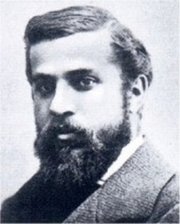|
|

Parcguell.jpg
Antoni Gaudí i Cornet (in Spanish, Antonio Gaudí), (25 June 1852–10 June 1926) was a Catalan architect famous for his unique designs expressing sculptural and individualistic qualities.
He was born in the town of Reus, west of Tarragona, Spain to a family of four generations of metalsmiths. Educated from 1873 to 1877 at the School of Architecture in Barcelona, Catalonia, he worked all his life there.
His first works were influenced by gothic and traditional Catalan architectural modes but he developed his own distinct sculptural style. Gaudí was strongly influenced by the French architect Eugene Viollet-le-Duc who promoted the return to an evolved form of Gothic architecture. But Gaudí surpassed Viollet-le-Duc, and created buildings and designs that were highly original - irregular, fantastically shaped with intricate patterns. Some of his masterworks, most notably, La Sagrada Família have an almost hallucinatory power.
He brought the parabolic arch, the organic shapes of nature, and underwater fluidity into architecture. While arriving at the form of his buildings he used catenary principles using a scaled model and observing the forces of gravity. He also used the Catalonian trencadís technique of broken tiles to decorate surfaces.
He was ridiculed by his contemporaries, at first supported only by the rich industrialist Eusebi Güell. His fellow citizens referred to the Casa Milà as La Pedrera ("the quarry"). George Orwell, who stayed at Barcelona during the Spanish Civil War, very much disliked his work. As time passed, though, his work became recognised and he is considered one of Catalonia's best and brightest.
Gaudí's work has been categorised with the Art Nouveau style of architecture, a precursor to modern architecture. But his adoption of biomorphic shapes and repudiation of straight lines and flat surfaces make him sui generis, a category unto himself in architectural history, related most closely to the later Austrian architect Friedensreich Hundertwasser.
Gaudí was an ardent Catholic and a fervent Catalan nationalist. (He was once arrested for speaking in Catalan in a situation considered illegal by authorities.) In his later years, he left secular work and devoted all his time to Catholic religion and his Sagrada Familia. On June 7, 1926 he was run down by a tram and lay in a public ward, unrecognized because of his careless attire, his empty pockets, and the relative obscurity of his last years. He died three days later.
Though acknowledged as a genius, there is a theory that Gaudí was color blind and that it was only in collaboration with Josep Maria Jujol, an architect 27 years his junior whom he acknowledged as a genius in his own right, that he produced his greatest works.
Gaudi's major works in chronological order :
- Casa Vicens (1878-1880)
- Palau Güell (1885-1889)
- Colegio de Santa Maria de Jesús (1889-1894)
- Santa Coloma de Cervelló (1898-1915)
- Casa Calvet (1899-1904)
- Casa Batlló (1905-1907)
- Casa Milà (La Pedrera) (1905-1907)
- Parc Güell (1900-1914)
- Sagrada Família (1884-1926)
Many of these works are found in the Eixample district of Barcelona, and three of them, the Parc Güell, Palau Güell, and Casa Milà, are UNESCO World Heritage Sites.
He left a draft of an aborted project for a sky-scraper Hotel Attraction in New York. It was the inspiration for a reconstruction project for the World Trade Center after September 11, 2001.
A process to get Gaudí declared blessed by the Catholic church is being promoted since 1992 by a secular association.
The 1987 album Gaudi by The Alan Parsons Project was inspired by Gaudi's life and work.
External links
- Asociación pro Beatificación de Antonio Gaudí (http://www.gaudiclub.com/esp/e_links/e_beat7.asp)
- Gaudí category (http://dmoz.org/Arts/Architecture/History/Architects/G/Gaud%ed,_Antoni/) at DMoz.
- Antonio Gaudí Architecture (http://www.barcelona-tourist-guide.com/gaudi/barcelona-gaudi.html)Template:Commons2
bg:Антони Гауди ca:Antoni Gaudí i Cornet de:Antoni Gaudí eo:Antoni GAUDI es:Antonio Gaudí fi:Antoni Gaudí fr:Antoni Gaudí gl:Antoni Gaudí he:אנטוני גאודי hu:Antonio Gaudí it:Antoni Gaudí ja:アントニオ・ガウディ nl:Antonio Gaudi pl:Antoni Gaudí pt:Antoni Gaudí ro:Antonio Gaudi ru:Гауди-и-Корнет, Антонио sk:Antoni Gaudí sl:Antoni Gaudí sv:Antoni Gaudí uk:Гауді Антоніо zh:安东尼·高第


